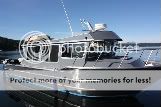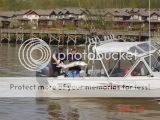News
NL Auditor General Raises Concerns on Salmon Aquaculture
January 23rd, 2009
Newfoundland Should Heed Auditor General’s Advice on Salmon Aquaculture
Note: Backgrounder of points made by Auditor General available as one-pager.
For immediate release
January 23, 2009
St. Andrew, NB –The Atlantic Salmon Federation (ASF) and the Salmonid Council of Newfoundland and Labrador (SCNL) are very concerned that the Government of Newfoundland and Labrador has failed to implement legislation and to update and complete management plans and codes of practice that are necessary to support an orderly and sustainable expansion of Atlantic salmon aquaculture in southern Newfoundland.
“We hope that the provincial government heeds a report by the Auditor General of Newfoundland and Labrador, outlining deficiencies in the present management of this industry, and takes steps to improve. This industry can have serious negative impacts on the province’s wild salmon populations, and the Auditor General’s report confirms that our concerns with an aquaculture industry that began in Bay d’Espoir and is expanding to Fortune Bay and Placentia Bay are justified,†said Don Ivany, Regional Director of ASF.
It is especially discouraging that the Code of Containment is deficient as lack of good containment leads to break up of cages and escapes of farmed salmon into the wild. This results in interactions with wild salmon in nearby salmon rivers and threatens the survival of these fish that are already in decline. There has been a noticeable reduction in returns to the rivers nearby the aquaculture sites, such as the Grey and Conne rivers. Where many Newfoundland rivers had very good runs in 2008, much improved over 2007, these southern rivers did not do as well and Fisheries and Oceans are concerned at their continuing unhealthy state.
Negative interactions between farmed and wild salmon have been scientifically documented and include both ecological interactions and genetic impacts of inter-breeding. Inter-breeding of farmed with wild salmon can result in reduced lifetime reproductive success, lowered fitness and decreased population productivity over at least two generations. Wild salmon can also become infected with disease and parasites spread from farmed fish.
“We urge the province to provide adequate infrastructure to support current and future expansion of the industry. It must act quickly to finalize an aquaculture health management plan, and implement a comprehensive inspection system to discourage flaunting of the rules, which the Auditor General indicates presently lack the power of effective legislation,†concluded Mr. Ivany.
-30-
The Atlantic Salmon Federation (ASF) is an international, non-profit organization that promotes the conservation and wise management of wild Atlantic salmon and their environment. ASF has a network of seven regional councils (New Brunswick, Nova Scotia, Newfoundland, Prince Edward Island, Quebec, Maine and Western New England). The regional councils cover the freshwater range of the Atlantic salmon in Canada and the United States.
The Salmonid Council of Newfoundland and Labrador (SCNL) is an umbrella organization consisting of a variety of groups whose main objectives are dedicated to the conservation and wise management of salmonids (Atlantic salmon, brook trout, brown trout, sea trout) and their habitat.
Contacts:
Don Ivany, ASF Regional Director for Newfoundland and Labrador
709 632-5100 (Office) 709 632-1155 (Cell)
Don Hutchens, VP – SCNL
709 753-4968
Muriel Ferguson, ASF Communications Office
506 529-1033 or 506 529-4581
Backgrounder
NOTE:This backgrounder is available as a one-page .pdf file click here
Concerns of the Newfoundland & Labrador -Auditor General on Aquaculture ~ January 2009
Note: The page references in these bullets refer to those in the NL&LB Auditor General Report. For full report, go to:
http://www.ag.gov.nl.ca/ag/2008.htm
Overview of Salmon Aquaculture:
• In 2007 4,857 tonnes of salmon were produced, utilizing 38 marine sites, principally in Bay D'Espoir and Fortune Bay on the south coast. (p.234-236)
Development
• Aquaculture facilities are at times inadequate, and could lead to environmental issues. Example: only two of the four processing plants in proximity to the salmon aquaculture area have wastewater treatment systems. (p.245)
• Newfoundland has a single Atlantic salmon hatchery and imports juvenile fish from elsewhere.
• A new hatchery is planned for 2010 (p.245), yet a plan was not available to the auditor general.
• Department has failed to implement a regime to ensure adoption of best management practices in all farm operations (p.247)
Aquaculture Inspections
• All aquaculture sites were NOT inspected, as required by policy; not all issues identified during inspections were followed up; the inspection reports did not address all areas of concern and documentation of inspection results requires improvement
• 21 of 146 inspections required in 2007 were not done. (p.258)
• Site inspections not reported accurately, information insufficient, no requirement for site operators to sign off on inspections, and follow-up inspections not always carried out. (p.259)
• In 43 of 107 cases of deficiencies, government failed to issue a directive to correct the problems. (p.268)
• 30 of 163 aquaculture sites had hazards, no immediate corrections made, and 16 of the sites still had the hazards in 2008. (p.259)
Code of containment for fish is inadequate
•Problems include lack of detail on many aspects of cage emplacement, and no requirement for operators to keep records of inspections. (p.260)
• In winter 2007 inadequate moorings at one site led to excessive movement of nets and death of fish. There are no standards for moorings in NL, yet have been "under review" since 2002. (p.273)
• Fish handling standards are substandard compared with those of other parts of Canada (p.260)
• Inadequate government inspection of cage systems, and lack of detail on requirements for correction of deficiencies. (p.260-261)
• Fewer sites were inspected in 2007 than in either 2006 or 2005 (p.263)
• The government is failing its requirement to determine if closed sites are returning to natural conditions. 42% of sites closed in 2007 have not been inspected at all (p.267)
• Despite being asked to review fish escape recapture gear, the department has not done so, and has no understanding of what is appropriate for responding to a significant fish escapement event in the province (p.275)
• Industry code of practices remains outdated (p.275)
• Cage System Audit Report inadequate, and some nets found in service had failed strength test. (p.278)
• Information in the government database on aquaculture sites is not complete or accurate, and the department delayed in providing information. Problems with the system mean that operator production information was not available for 2003 to 2006. (p.279)
ASF & SCNL
DON IVANY
Regional Director
Corner Brook, NL
donivany@swgc.mun.ca
Tel: (709) 632-5100
ASF COMMUNICATIONS
St. Andrews, NB
savesalmon@asf.ca
Tel: (506) 529–4581
www.asf.ca
asf.ca/docs/uploads/nl-back6.pdf RELATED ISSUES:
Aquaculture
If you have any comments on Atlantic salmon issues and coverage, or would like further information, contact:
Sue Scott, V.P. Communications
1-506-529-1027
E-mail:
policy@nb.aibn.com



